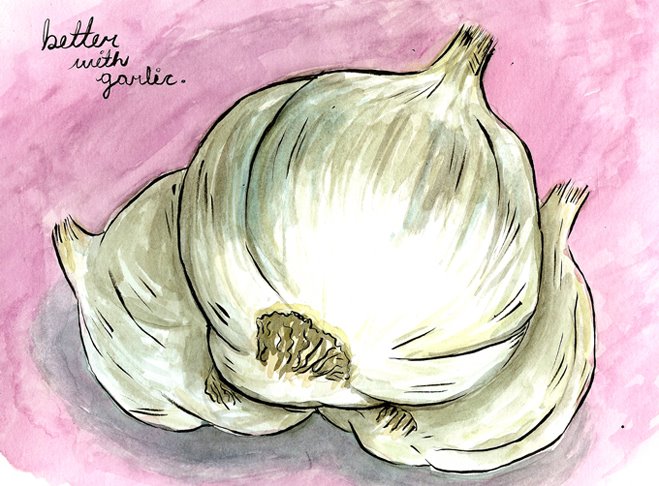One of the desserts that will always remind me of home is strawberry-rhubarb pie. I have a vague memory of the first one I ever had. I can’t remember where or who I was with or why I was wherever I was, but I do remember the combination of tart rhubarb and ridiculously sweet strawberries. It’s always stuck with me.

When I was at the farmer’s market and saw this ridiculously beautiful rhubarb, I knew I had to get it. I also bought a very large amount of strawberries, which I am surprised made it home because they were just so sweet, I kept snacking on them on the walk back. Anyway, for a pie that reminds me of home, of course I had to use The Fiddlehead Cookbook. Hometown cookbook, hometown pie, happy Becca. I didn’t use the crust recipe they use, instead subbing in the one my mom sent me oh so long ago. Use it. It’s amazing. I had extra rhubarb and strawberries and this is reflected in the recipe below. I also noted the original amounts. Oh yeah, and make sure you get the leaves off of your rhubarb. Those are poisonous.
Strawberry-Rhubarb Pie from
The Fiddlehead Cookbook:
1 9” pie (8 pieces)
1 unbaked double 9” pie crust (see the recipe I use
here).
5 c. sliced fresh rhubarb stems (orig. 4 c.)
1½ pint fresh strawberries, washed, patted dry, and stems removed. Large ones cut into quarters. (Orig. 1 pint)
1/3 c. all-purpose flour
1 1/3-1½ granulated sugar, depending on the sweetness of your strawberries. Mine were sweet, so I went to the low side.
½ tsp. ground cinnamon
2 Tb. butter

Place rhubarb, strawberries, flour, sugar, and cinnamon in a large glass or stainless steel bowl, mix well, and allow to sit for 15 minutes.


Preheat oven to 400 degrees and place rack in center of oven. Pour rhubarb mixtures into unbaked shell, mounding toward center. Dot filling with butter, cut into teaspoons. Use water to dampen lip of pie shell. Loosely fold top crust in half and transfer to pie. Unfold and center on pie. Trim upper crust to match lower. Folding under, pinch two layers of crust together to create a secure and attractive edging to pie. Yeah, I sort of tried to do this. It was pretty enough.
With a fork or a small knife, make a pattern of small holes or slits in top of pie. Lightly dust with a pinch of sugar and place in oven. Put a cookie sheet lined with foil on shelf directly below pie to catch any drips. This is pretty good advice for any pie baking you may do, FYI.

Bake at 400 degrees for 10 minutes, then reduce heat to 375 and bake for 40 to 45 minutes, until juices are bubbling out of slits in center of pie. Mine was done at 40.

Remove from oven and allow to cool on a rack for 30 minutes or more before cutting. Serve warm or at room temperature with vanilla ice cream. Cover tightly and store at room temperature for 1 day, longer in the refrigerator.
This pie was so good! I loved it! The only oopsie I made was not adding more flour when I added in more fruit. As a result, it was a little more liquidy than I would have liked, but still very tasty and not so soggy as to be an off texture. The crust is very forgiving and a small error like that didn’t ruin the pie. While it is best day of, I loved eating this for the next few days afterward. This is a perfect late spring pie.
 Bake potatoes, mixed in olive oil and oregano, in a 375 degree oven for about 5 minutes. Roll out galette dough. Spread the ricotta cheese over the dough, sprinkle with chopped garlic and oregano, and cover with potato slices. Fold in the dough and sprinkle with sea salt. Bake for about 30 minutes in a 400 degree oven. My potatoes cooked a little longer in the first step than I would have liked and as a result were a bit crispier than intended at the end of baking. It still rocked though. I will definitely do this one again and keep on experimenting with galettes. How can crispy dough and garlic ever be anything but amazing?
Bake potatoes, mixed in olive oil and oregano, in a 375 degree oven for about 5 minutes. Roll out galette dough. Spread the ricotta cheese over the dough, sprinkle with chopped garlic and oregano, and cover with potato slices. Fold in the dough and sprinkle with sea salt. Bake for about 30 minutes in a 400 degree oven. My potatoes cooked a little longer in the first step than I would have liked and as a result were a bit crispier than intended at the end of baking. It still rocked though. I will definitely do this one again and keep on experimenting with galettes. How can crispy dough and garlic ever be anything but amazing?
.jpg)
























